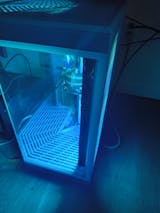Whether you’re new to the world of PC gaming or your PC is in dire need of a boost, overclocking is one of the best ways to maximize performance overall. Even a small bump in performance can delay the need to upgrade your CPU and save you time or money in the long run. With over 20 years of experience, XOTIC PC offers the know-how you need to try overclocking without damaging your computer. In this guide, we teach gaming enthusiasts, graphic artists, and media streamers how to safely overclock. With our help, some time, and patience, you can boost CPU speeds by 10 percent or even more.
What is Overclocking?
Don’t let the overclocking competition photos or videos fool you. Overclocking is not all about liquid nitrogen. You can actually overclock a wide variety of PC parts, but we’ll focus on the CPU for this overview. Overclocking allows you to squeeze as much performance as you can from the current components in your PC, so you can avoid spending more than you need to on newer, faster components. Overclocking starts with tweaking your hardware so that it runs faster than the manufacturer intended. The central processing unit (CPU) is like the “brain” of your computer, and it can be overclocked by adjusting the settings through either the motherboard’s Unified Extensible Firmware Interface (UEFI) or Basic Input/Output System (BIOS). As long as you tweak the CPU in moderation, you shouldn’t damage your PC.
Before You Overclock
There are a few things to consider before you attempt overclocking for the first time. First, not all processors can be easily overclocked. Double check whether your AMD or Intel processor is unlocked. Second, a CPU produces more heat when you add more voltage. By the same token, you need more voltage to power higher clock speeds. Last but not least, there is only so much voltage your PC can handle before you see a drop in frame rates. You might also see corrupting processes or experience a failure to boot. Overclocking comes with serious risk, especially for PC novices. If you can find the delicate balance between speed and heat, you can achieve a stable overclock on your CPU.
Overclocking Your CPU
- Download free stress testing software to double check PC stability at both idle and maximum load. You can also download a program to monitor the temperature output of your CPU.
- Load your temperature monitoring program. Pay close attention to the lowest core temperature to give yourself a good idea of how hot your CPU runs.
- Perform stress tests on your processor at stock settings to see how it performs at 100 percent.
- Once CPU temperatures stabilize, restart your PC and access the BIOS settings. Locate the overclocking tab, which will provide overclock profiles according to what kind of CPU is installed. Set the motherboard to run one of the overclock profiles so it will attempt to overclock the chip to that frequency without needing any input.
- Depending on your experience level, you might like more manual control. Try changing the CPU multiplier/ratio to a target number. Working with the base clock frequency, the multiplier will determine the final figure in GHz. You should attempt to overclock your CPU in small increments. Save any changes and exit the BIOS settings.
- Reboot and return to Windows, so you can monitor the temperature of your CPU. If you’re using Prime95 or a similar software, run what’s called the “Torture Test” and “Blend Test” to see how your chip does at maximum load. If your CPU is stable after five minutes, you can start to change the multiplier.
- Increase the CPU multiplier by one and perform stress tests each time it changes until your PC displays a stop error, the “Blue Screen of Death,” or the temperatures reach hazardous levels.
- If your PC crashes, the voltage is not high enough and it needs to be raised. In the BIOS overclocking settings, locate the CPU Core or VCORE value. From the stock settings, change the VCORE value of your CPU by only 0.01 volts until you can effectively boot, stress test, and sustain stability at the frequency you want to achieve.
- When you can’t reach the next frequency, it is time to dial back the overclock by 0.1GHz and restore the VCORE voltage back to the last stable setting. You’ve reached your final overclock settings.
With time and a little experience, you will learn how your CPU responds to various amounts of voltage.













